ARC-PA 5th Edition Standards: Presenting Data for Appendix 14C

I’m glad you’ve joined us again for our series on unpacking the new and improved 5th Edition Standards, Appendix 14. In today’s blog we examine the requirements of Appendix 14C and how you may respond clearly and succinctly in your SSR.
Appendix 14C requires data on the effectiveness of a program’s didactic curriculum. Your data should include student evaluations of their didactic courses and instructors, the number of final didactic course grades at “C” or below, and the attrition and remediation in didactic courses.
Student Evaluations of Courses and Instructors
When graphing student evaluations, we list all didactic courses by their name and number. We identify faculty by the abbreviations found in the glossary (MD for Medical Director, PD for Program Director), then numerically. So, your Principal Faculty Members (glossary term PF) would be numbered as PF-1, PF-2, and so on.
You must present data in a way that allows comparison across courses for faculty who teach multiple classes, and which allows appreciation for trends over time.
Present quantitative data in aggregate, in tables/graphs that support the analysis directly.
Present quantitative data in “themes,” summarized in the narrative or displayed in an appended document. Quantitative data must also support the narrative. You select the themes of your quantitative data. Provided they are reasonable and sensible, the commission will accept them.
The following Chart A shows a way to line the data up in one graph. The data shows course ratings over a period of about five years, then combines it with thematic elements noted in qualitative data.
Chart A
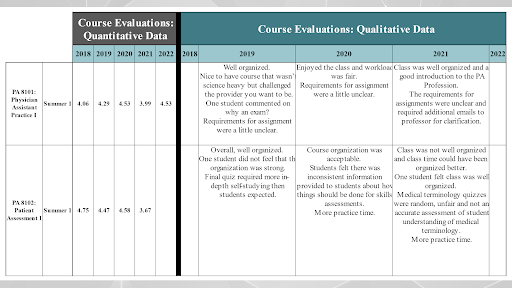
Number of Didactic C-Grades and Below
Chart B below displays the number of C-or-below grades in particular classes, then Chart C relates a student’s number of C-grades to their various other course work. This gives us the ability to see, based on C-grades, all the way to the PANCE. We can surmise from the chart that an increase in C-grades relates to a decline in PANCE performance.
Chart B
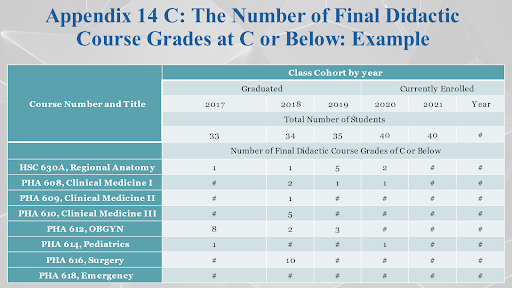
Chart C
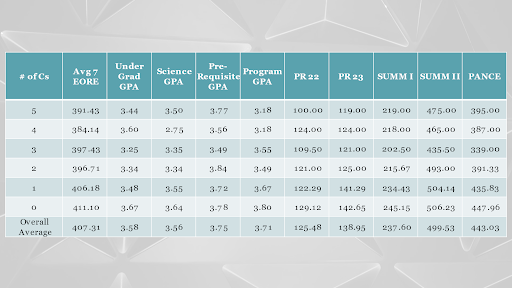
Attrition and Remediation in Didactic Courses
The ARC-PA defines remediation as the program-defined and applied process for addressing deficiencies in a student’s knowledge and skills, such that the correction of these deficiencies is measurable and documentable.
Data to measure:
- How many students have repeated didactic courses in the three most recent graduating classes, as well as the classes currently enrolled?
- How many students in the three most recent graduating classes, as well as the classes currently enrolled, has the program identified as having deficiencies in knowledge and skills during the didactic curriculum, such that the correction of these deficiencies (remediation) was necessary for the student to continue in the program (not including those who repeated a didactic course)?
- If any students repeated or remediated didactic courses as indicated in the above two questions, provide narrative describing, in summary, aspects of the program remediated or repeated. Include outcomes in aggregate (e.g., progress in the program, graduation rates, PANCE pass rates).
Chart D displays a simple total of remediations offered to members of a cohort.
Chart D
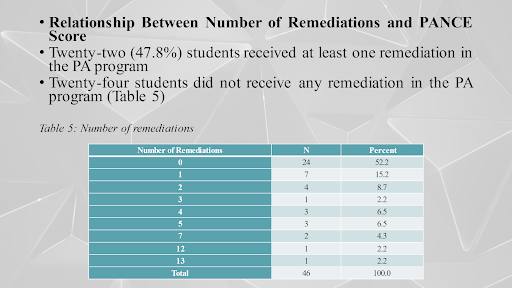
Using parametric analysis to enhance assessment. The Commission Is not clear on how much, and when, you should do this. However, they use the term “correlation” many times in their literature, so in my estimation, correlating performances are important. They open a new layer of assessment that can help you to look at this information.
In Chart E, I share an example of an analysis of variance conducted on C-grades received and PANCE performance.
Chart E
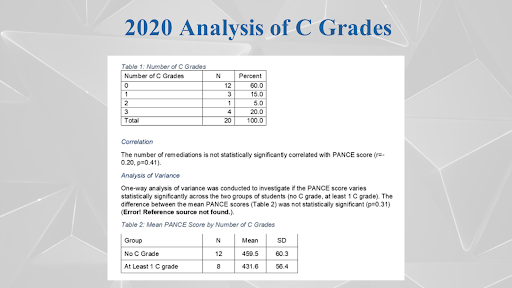
If you would like to know more about conducting regression studies on your student outcomes, I discuss the use of parametric analysis in depth in Massey Martin, LLC’s free online seminar series on the ARC-PA’s 5th Edition Standards. I invite you to attend and ask questions.
In our next blog post, we’ll continue with the 5th Edition Standards by discussing Appendix 14D.

